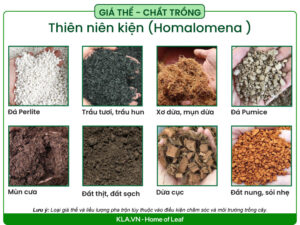Millennium var (Homalomena variegated)
Note: The above information is only relative, the living conditions of the tree also depend a lot on other objective factors.
How to grow and care for Homalomena Variegated
Growing difficulty of Homalomena variegated
Difficulty: 2-3/6
Homalomena variegated is great for beginners or busy people because:
✅ Tolerates partial shade well, does not require strong light
✅ No need to water too often
✅ Grows well in humid tropical interior conditions
Soil for planting Homalomena variegated
Homalomena variegated has rhizomes rather than taproots, so it needs loose, well-drained soil that remains lightly moist around the roots.
📌 Recommended soil formula:
✅ 1 part humus or light loam
✅ 1 part coconut fiber or peat moss (moisture and nutrition retention)
✅ 1 part perlite or burnt rice husk (increases ventilation)
✅ 1 part pine bark chips or pumice (helps with drainage and prevents compaction)
🚫 Don't: hard, water-retaining soil, or clay-rich mother garden soil
💡 Notes when planting:
- The pot must have a drainage hole at the bottom.
- Apply organic fertilizer (worm castings, fish manure or slow-release fertilizer) 1–2 months/time
- After a year, the soil should be changed to avoid mineral salt accumulation.
Suitable lighting for Homalomena variegated
📌 Lighting details:
✅ Best: diffuse light, such as near an east or north facing window, or in light shade
✅ Withstand: Low light indoors, but leaves will be small, pale in color, the plant will take a long time to grow new leaves
🚫 Absolutely avoid:
- Direct sunlight, especially midday or afternoon sun from the West/Southwest direction
- Place the plant near a hot light source like a halogen lamp — it can easily burn or dry out the leaves.
💡 Special Note:
- New leaves are small, have curled edges or change color → may be due to lack of light
- If grown in a dark room without windows → use LED plant growing lights, place 30-40 cm away from the plant, light 10-12 hours/day
📍 Ideal location:
- Next to the window, use thin curtains, 0.5–1.5m distance if the door faces South
- Grow in a room with diffused natural light, avoid harsh sunlight
- Do not place near high heat sources
Temperature suitable for Homalomena variegated
🌿 Ideal temperatures for the Millennium plant var (Homalomena variegated): 18 - 28°C
📌 Characteristic:
- Likes warm, humid environments, does not tolerate cold or sudden temperature changes
- Very sensitive to temperatures below 12 °C or above 32 °C
🚫 When temperature < 12 °C:
- The tree was damaged. cold shock, leaves become soft, yellow or fall off
- Roots lose the ability to absorb water
🚫 When temperature > 32 °C and humidity is low:
- Withered leaves, dry, brittle edges, crushed, slow to grow new leaves
📌 Care notes:
✅ Avoid cold wind from air conditioner, open windows at night
✅ Do not place the plant near the heater or stove.
✅ On hot days: increase humidity by misting, placing trays of water/pebbles, or using a humidifier
📍 Signs of affected plants:
- Too cold: leaves are soft, discolored, roots do not absorb water
- Too hot/dry: crispy leaf edges curl inwards, stem is not firm
Water give tree Homalomena variegated
Homalomena variegated is a tree native to the moist tropical forests of Southeast Asia, especially Borneo and Malaysia. It grows well in high humidity and lightly moist soils, but very sensitive to waterlogging, especially in the rhizome – which is prone to rot if left in water for a long time.
📌 Watering principles:
✅ Water the entire soil ball deeply. Each time you water, make sure the water seeps to the bottom of the pot and flows out through the drainage holes. This helps stimulate even root growth and limits the accumulation of mineral salts in the upper part of the soil.
✅ Check soil moisture before watering: Use your hand to lightly press the soil layer about 2-3 cm from the surface of the pot. Only water if it feels dry. Can be used moisture test strip or hygrometer to ensure accuracy.
✅ Reduce watering frequency in the rainy season, winter or when the plant grows slowly (usually from late autumn to early spring). When the plant has few new leaves, the roots absorb water more slowly, so watering too much can cause the roots to become waterlogged and die silently.
🚫 Never water on a fixed schedule without checking the soil moisture.
Unusual yellowing, softening, water spots or foul odors around the base of the leaves are warning signs that the roots are waterlogged – stop watering and check the soil and roots immediately.
📍 How many times a week to water?
Hot season (Spring – Summer):
• Watering 1–2 times/week, depending on light, wind and ventilation conditions of the pot. If planted in a terracotta pot or dry space, more watering may be required.
• In air-conditioned environments, humidity should be checked every 2–3 days.
Cold season (Autumn – Winter):
• Watering only 7–10 days/time, even longer if the plant does not take up water quickly. Prefer consistent moisture over watering too often.
💡 Water control tips:
-
Place the pot in a drainage trough or liner tray., do not use a double pot without drainage holes (cachepot) if you cannot control the amount of excess water carefully.
-
If you accidentally water too much, tilt the pot to drain excess water, place in a well-ventilated area and check again after a few hours.
-
Use well drained soil will help reduce the risk of root rot.
📌 Hydroponics (less common but possible):
Can be used for Selby if the rhizome is kept above water, not completely submerged. Use activated charcoal or lightweight rocks to stabilize the roots.
✅ Change water 1–2 times/week
✅ Ensure good light and air circulation to prevent mold and algae
Humidity give Homalomena variegated
Homalomena variegated is a moisture-loving plant that grows best in moist conditions. from 60% to 80%Although it is adaptable to indoor environments with average humidity, the plant will grow vigorously and have healthier, shiny leaves when living in high humidity environments, especially during the dry season or when using air conditioning.
📌 How to maintain proper humidity for Homalomena variegated:
✅ Spray a light mist every morning, avoid spraying at night to limit the risk of fungus and disease.
✅ Place the tree on gravel tray with water to create micro-humidity around the pot.
✅ Use Humidifier in the room when the air is dry.
✅ Planted with other tropical plants such as Calathea, Alocasia, helps increase natural humidity through transpiration.
Ideal pH give Homalomena variegated
Homalomena variegated grows well in soils with a pH ranging from 5.5 to 6.5 – slightly acidic. This pH helps plants absorb nutrients well, especially magnesium (Mg), calcium (Ca) and iron (Fe), supporting photosynthesis and foliage growth.
🌿 If pH lower than 5.0, the tree may be calcium and magnesium deficiency, leading to leaves turn yellow, become soft and weak, leaf edges may be burnt.
🌱 If pH above 6.5, at risk iron deficiency, leading to young leaves are yellow, veins are green (sign of trace element deficiency).
💡 Soil pH Care Tips:
- Check pH periodically with test strips or soil pH meter.
- If pH is too low, add agricultural lime (dolomite) to neutralize acid.
- If pH is too high, add compost, sphagnum moss or crushed pine bark to naturally lower pH.
Pet-friendly
Millennium var (Homalomena variegated) is unsafe with pets like dogs and cats. This species contains calcium oxalate needle – caustic irritation of mouth, throat and digestive system when chewed or swallowed.
⚠️ Symptoms if pet eats:
- Drooling constantly
- Red, swollen, painful mouth, possibly with mild ulcers
- Vomiting, loss of appetite, fatigue
🚧 Precautions:
- Place the plant on a high shelf or in a place where pets cannot reach it.
- Use Anti-bite spray, especially for homes with curious cats
- Train pets to stay away from plants
💡 Additional notes for growers of Homalomena variegated:
💡 This species prefers partial shade – avoid direct sunlight on the leaves, which can easily burn them. Place near a window with thin curtains or use a neutral light grow light.
💡 Trees tend to direction of light, rotate the pot 1-2 times/week to keep the foliage balanced.
💡 Homalomena rhizomes grow well in the environment loose, well-drained substrate such as: soil mixed with coconut fiber, pine bark, perlite and a little sphagnum moss to retain moisture.
💡 May “secrete” (guttation) if air humidity is high or soil stays moist for too long – normal physiological phenomenon.
💡 Breeding by dividing the rhizome bush – easy in early spring, allowing the mother plant to air out and the young plants to grow independently.
Indoor Plant Care Guide
The most important and basic knowledge about growing plants indoors:





